- 1Auckland Bioengineering Institute, University of Auckland, Auckland, New Zealand
- 2The New Zealand Institute for Plant & Food Research Ltd., Auckland, New Zealand
Maximising FAIRness of biosimulation models requires a comprehensive description of model entities such as reactions, variables, and components. The COmputational Modeling in BIology NEtwork (COMBINE) community encourages the use of Resource Description Framework with composite annotations that semantically involve ontologies to ensure completeness and accuracy. These annotations facilitate scientists to find models or detailed information to inform further reuse, such as model composition, reproduction, and curation. SPARQL has been recommended as a key standard to access semantic annotation with RDF, which helps get entities precisely. However, SPARQL is unsuitable for most repository users who explore biosimulation models freely without adequate knowledge of ontologies, RDF structure, and SPARQL syntax. We propose here a text-based information retrieval approach, CASBERT, that is easy to use and can present candidates of relevant entities from models across a repository’s contents. CASBERT adapts Bidirectional Encoder Representations from Transformers (BERT), where each composite annotation about an entity is converted into an entity embedding for subsequent storage in a list of entity embeddings. For entity lookup, a query is transformed to a query embedding and compared to the entity embeddings, and then the entities are displayed in order based on their similarity. The list structure makes it possible to implement CASBERT as an efficient search engine product, with inexpensive addition, modification, and insertion of entity embedding. To demonstrate and test CASBERT, we created a dataset for testing from the Physiome Model Repository and a static export of the BioModels database consisting of query-entities pairs. Measured using Mean Average Precision and Mean Reciprocal Rank, we found that our approach can perform better than the traditional bag-of-words method.
1 Introduction
In developing a biosimulation model, it is essential to provide a comprehensive description of the entities of the model related to processes, reactions, variables, mathematical equations and parameters. Formally, the COmputational Modeling in BIology NEtwork (COMBINE) community recommended the description in the form of semantic annotations using the Resource Description Framework (RDF) technology (Neal et al., 2019). With semantic annotations, complete and precise description is constructed in a composite manner involving various knowledge source terms and their relationships in a structured form (Gennari et al., 2011). Further, composite annotations are used as a community standard to encourage platform interoperability and sharing and collaboration between modellers (Gennari et al., 2021; Welsh et al., 2021). This work supports this recommendation and goes beyond the composite annotation structure to provide an entity retrieval method with a simple data structure that is easy to deploy. Moreover, the method should be general enough so it can be implemented for different domains with composite annotations.
This complete and precise description is beneficial for understanding the model and subsequently becomes the key to rediscovery for verification and possible reuse. Verification that includes model curation ensures experimental results’ validity, reproducibility and consistency. Scientists can then confidently compare models or evaluate their proposed approaches. More comprehensive usability will enable model composition, creating larger-scale models, which is an essential aspect of modelling human physiology as a whole (Bassingthwaighte, 2000) and understanding the human body (Hunter et al., 2002).
The standard technology to locate and manipulate data stored in RDF format is SPARQL Protocol and RDF Query Language (SPARQL). SPARQL is powerful for retrieving data specifically and precisely (Pérez et al., 2009), although it requires a rigid syntax query. This rigidity becomes a barrier for most users even if they already have enough knowledge regarding the RDF triple and ontologies to explore RDF. For expert users, their queries still may fail caused by misspellings, capitalisation, and ontology term variation. Therefore, text-based queries that can be composed freely, as in commercial search engines, are preferred, although the results are less precise.
The current state-of-the-art approaches offer a workaround by converting text-based queries to SPARQL by leveraging deep learning. Most of the works are for question-and-answer tasks on general knowledge, for example, about an object’s location and public figures’ achievements; hence, they do not explicitly support the search of entities annotated compositely. The knowledge base used is generic RDF triple graphs such as DBPedia1, Yet Another Great Ontology (YAGO)2, and Wikidata3. These graphs maintain a massive amount of information about entities and their facts, extracted from various sources such as Wikipedia and GeoName. The community and users manually validate information, so the level of accuracy is relatively high. Soru et al. (2020) and Yin et al. (2021) have considered the conversion as a language translation problem where SPARQL is the foreign language. Soru et al. (2020) implemented Long Short-Term Memory (LSTM) architecture to build sequence-to-sequence models and train the model over a dataset extracted from DBPedia. Then, Yin et al. (2021) extended the work by investigating the use of eight Neural Machine Translation (NMT) methods built using Convolutional Neural Network (CNN), Recurrent Neural Network (RNN), and Transformer. CNN-based method (Gehring et al., 2017) performed the best within these methods, followed by Transformer-based (Vaswani et al., 2017). However, in the context of natural language translation, the use of Transformer is prospective to improve performance since it is not as mature as RNN and CNN. With the popularity of Bidirectional Encoder Representations from Transformers (BERT) (Devlin et al., 2018), Tran et al. (2021) created SPBERT, a Transformer-based model pre-trained using a large DBPedia dataset for natural language to SPARQL and query results verbalisation tasks, and proved that the Transformer-based approach could surpass RNN and CNN. Adapting the created model for a new model is efficient by finetuning the existing model with less training data while keeping the property of the original model. Nevertheless, the text converted in these approaches must be in the natural language templates as formatted in the dataset. They cannot accommodate properly unstructured queries using keywords such as those used on commercial search engines.
Working well with structured and unstructured text-based queries, Natural Language Interface for Model Entity Discovery (NLIMED) provides an interface to retrieve entities annotated compositely (Munarko et al., 2022). It identifies phrases in the query associated with the physiological domain and links them to possible ontology classes and predicates. The link results are then composed as SPARQL and executed at the SPARQL endpoint to retrieve entities. A similar tool was developed by Sarwar et al. (2019), Model Annotation and Discovery (MAD), with the same domain but limited to entities in epithelial models. This limitation relates to template-based methods whose templates are customised for a particular topic, so adding topic coverage requires new templates.
This paper presents CASBERT, a method to retrieve entities in biosimulation models that are annotated compositely. We apply the information retrieval paradigm and leave the complexity of SPARQL providing a more expressive query composition while maximising the advantages of BERT. By adopting Sentence-BERT (Reimers and Gurevych, 2019), composite annotations describing entities are pre-calculated into entity embeddings and stored into a list of entity embeddings. With the entity embeddings, a query that is also converted into a query embedding is compared using a similarity formula; then, the ranked results are displayed.
With CASBERT, researchers can now explore information about entities in biosimulation models stored in a repository. They can find and access information quickly and adequately, including parameter values, variable units, variable types, and mathematical equations. CASBERT allows users to create expressive queries as keywords or natural language, such as ‘concentration of triose phosphate in astrocytes’. This convenience accelerates model validation, reproduction and reuse, directly supporting the principles of FAIR (Findability, Accessibility, Interoperability and Reusability) data.
Recently, the biosimulation model formats in the two largest repositories, the Physiome Model Repository (PMR) (Yu et al., 2011) and the BioModels Database (Chelliah et al., 2015), have used RDF to describe their entities. Composite annotations are largely used to describe models in CellML (Cuellar et al., 2003) and SBML (Hucka et al., 2003) formats, detailing entities with terms in ontologies such as anatomical location, chemical compound, physics of biology, gene, and protein. We generated test data from these repositories in query and entity pairs. CASBERT performance was measured using Mean Average Precision and Mean Reciprocal Rank, and compared to the traditional bag-of-words method, the score was significantly higher. In addition, entity embeddings stored as a list are easy to manage, allowing for efficient addition, subtraction, and replacement processes, making them suitable for search engine implementations. CASBERT can also be implemented for composite annotation search in various domains such as chemistry, pharmacy, and medicine. Our implementation, dataset, and experiment setup are publicly available4.
2 Materials and methods
CASBERT provides an approach to converting composite annotations defining entities and queries to embeddings. Entity embeddings are pre-calculated and stored in a list of entity embeddings, whereas query embeddings are created on the fly when a request is made. Entities are then presented from the most relevant by initially calculating the similarity values between query embedding and entity embeddings.
The conversion to embedding methods are based on Bidirectional Encoder Representations from Transformers (BERT) (Devlin et al., 2018) by implementing Sentence-BERT (Reimers and Gurevych, 2019). For the experiment, we created a dataset by collecting composite annotations from biosimulation models from the PMR and the BioModels database. These conversion methods are described in the following subsections, starting with the dataset used.
2.1 Biosimulation model - Composite Annotation Query (BM-CAQ) dataset
We constructed the dataset for the experiment by extracting compositely annotated entities in the PMR (Yu et al., 2011) and the BioModels database (Chelliah et al., 2015). The PMR is a repository storing biosimulation models initiated by the Physiome Project (Hunter et al., 2002). Most models are written using the CellML standard and annotated using the RDF standard. The models usually are equipped with human-readable information that can be loaded as web pages. We can further simulate and analyse physiological processes by running models using tools such as OpenCOR (Garny and Hunter, 2015). Like the PMR, the BioModels database manages biosimulation models in more significant numbers. The models deposited in this repository are mostly written using SBML standard (Hucka et al., 2003).
Table 1 presents the example entities described compositely using the RDF standard in the PMR. These entities are variables of the brain energy metabolism model (Cloutier et al., 2009) whose CellML model is available in the PMR5. An entity is described by at least one or, ideally, more ontology classes to provide detailed and precise descriptions. In the examples, GAPg/GAPg is annotated with OPB:00340, CHEBI:17138, and FMA:54537, whereas dAMP_dATPn.ATPn is annotated with OPB:00340, CHEBI: 15422, and FMA:54527, where these ontology classes are concepts available in Ontology of Physics for Biology (OPB) (Cook et al., 2008), Foundational Model of Anatomy (FMA) (Rosse and Mejino, 2008), and Chemical Entities of Biological Interest (ChEBI) (Degtyarenko et al., 2008), respectively. Additionally, the relationship between an entity and ontology classes is specified using predicates where in the example, there are ‘bqbiol:isPropertyOf’, ‘bqbiol:isPartOf’, ‘bqbiol:isVersionOf’ and ‘bqbiol:is’. As a complement, although not mandatory, an entity may be provided with a literal description marked with the ‘dcterms:description’ predicate, for example, ‘Rate of change in the concentration of glyceraldehyde-3-phosphate in the astrocyte’ on GAPg/GAPg entity.
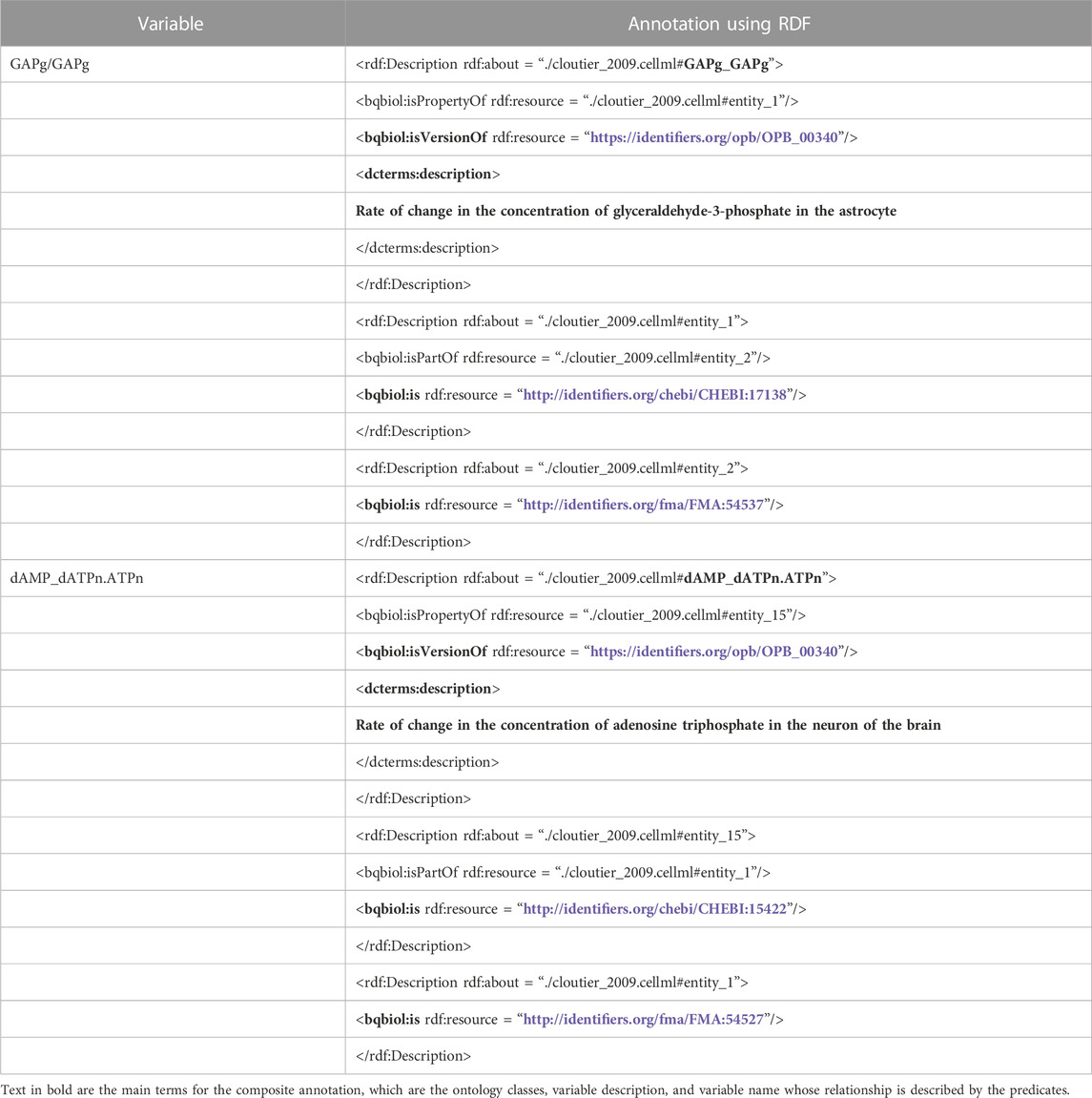
TABLE 1. The example of compositely annotated entities written using the RDF standard in the PMR. These entities are variables of the brain energy metabolism model, GAPg/GAPg and dAMP_dATPn.ATPn (Cloutier et al., 2009). They are described by ontology classes such as OPB_00340, CHEBI:17138, and FMA:54527; and predicates such as ‘bqbiol:isVersionOf’ and ‘bqbiol:is’. There are also literal descriptions marked by the dcterms:description predicate, although not all entities have one.
There are 13,360 entities6 in the RDF and CellML files in the PMR, and 4,652 have literal descriptions. These literal descriptions usually accurately summarise the composite annotations of entities, although some are not. We assume that an accurate literal description can be used as a query representation for testing CASBERT and can reflect future user queries. Therefore, our test data includes all accurate literal descriptions as valid queries and the related entities as relevant search objects. Altogether, there are 338 unique queries, each relating to one or many entities. Then, we will refer to this set of query-entity pairs as noPredicate because most queries do not explicitly have an RDF predicate term.
However, we anticipate that queries for specific entity searches mimicking SPARQL will include predicate terms. Therefore, we created the second set of query-entity pairs by inserting the terms in the predicates to the queries in noPredicate. Terms were chosen randomly based on a series of predicates determining the relationship between ontology classes and entities. For example, the GAPg in Table 1 and CHEBI:17138 (glyceraldehyde-3-phosphate) are linked by ‘bqbiol:isPropertyOf’ and ‘bqbiol:is’ so that the insert can use the ‘is property of’ and ‘is’. If ‘is property of’ is selected, the new query becomes ‘Rate of change in the concentration of is property of glyceraldehyde-3-phosphate in the astrocyte’. We got 534 additional query-entity pairs and name this set as withPredicate’.
We applied the same strategy to extract queries from the BioModels database, which returned 834 noPredicate and 1,541 withPredicate queries. In its entirety, this dataset is named Biosimulation Model - Composite Annotation Query (BM-CAQ) and sample data are shown in Supplementary Tables S1–S4. The source code for creating this dataset and testing CASBERT is available online7.
2.2 Composite annotation search using BERT (CASBERT)
We used Sentence-BERT (Reimers and Gurevych, 2019), a BERT-based sentence encoder, to convert queries and composite annotations to embeddings and to classify the query to be compared to the appropriate entity embedding list. BERT provides pre-training models built based on massive corpora that can be fine-tuned with a smaller corpus to maximise performance for domain-specific uses (Devlin et al., 2018). A sentence is converted into embedding by splitting to tokens and then calculating each token’s embedding unique to the context, such as the surrounding tokens and position. Therefore, the same token in different sentences will have a different embedding. This attention to context correlates with high reliability in several natural language processing tasks, such as named entity recognition, concept extraction, and sentiment analysis, and is relatively better than non-context embedding (Arora et al., 2020; Taillé et al., 2020). In addition, the form of the token, which is part of the sentence, makes BERT more adaptive to typographical errors and variations of word writing.
The most straightforward approach to create a sentence embedding is by averaging the token embeddings; however, this often leads to poor performance (Reimers and Gurevych, 2019). Resolving this issue, Sentence-BERT offers a better concatenation method optimised for Semantic Textual Similarity (STS) by applying Siamese (Bromley et al., 1993) and Triplet loss (Weinberger and Saul, 2009) networks.
In the following, we describe the CASBERT mechanism for transforming composite annotations to entity embeddings and queries to query embeddings.
2.2.1 Entity embedding
An entity embedding represents an entity as a dense vector whose dimensions match the sentence transformer model used. CASBERT generates this presentation by converting composite annotations to embedding. The annotation comprises triples which are subject, predicate and object expressions. These triples form a tree where the root is the entity’s name, the leaves are the ontology classes (objects), and the edges are the predicates. The predicates link the root and the leaves to form paths. The entity embedding is the average of all path embeddings, where the ontology class embedding and the predicate embeddings determine the path embedding.
Here we describe the process of converting composite annotations to entity embeddings. We use the GAPg/GAPg variable in Table 1 as a running example where all other composite annotations are processed similarly to become entity embeddings. Figure 1A shows the composite annotation regarding the concentration (OPB:00340) of glyceraldehyde 3-phosphate (CHEBI:17138) in an Astrocyte (FMA:54537). There are five triples with the subject and objects: root (GAPg/GAPg), ontology classes (OPB:00340, CHEBI:17138, FMA:54537), and intermediate subjects/objects (entity_1, entity_2). Figure 1B presents interconnected triples creating paths that display a clear relationship between root and ontology classes. The terms referred to as intermediate subject/object are usually generic and are similar across all composite annotations, so they cannot be used as a differentiator; therefore, we ignore them (Figure 1C). Next, we remove predicates that directly connect intermediate subjects, e.g. ‘is’, and ontology classes, because these only describe the intermediate subjects/objects, not the entity. We remove the prefix of the predicate term; for example, rather than ‘bqbiol:isPropertyOf’, we use ‘isPropertyOf’ as a predicate term.
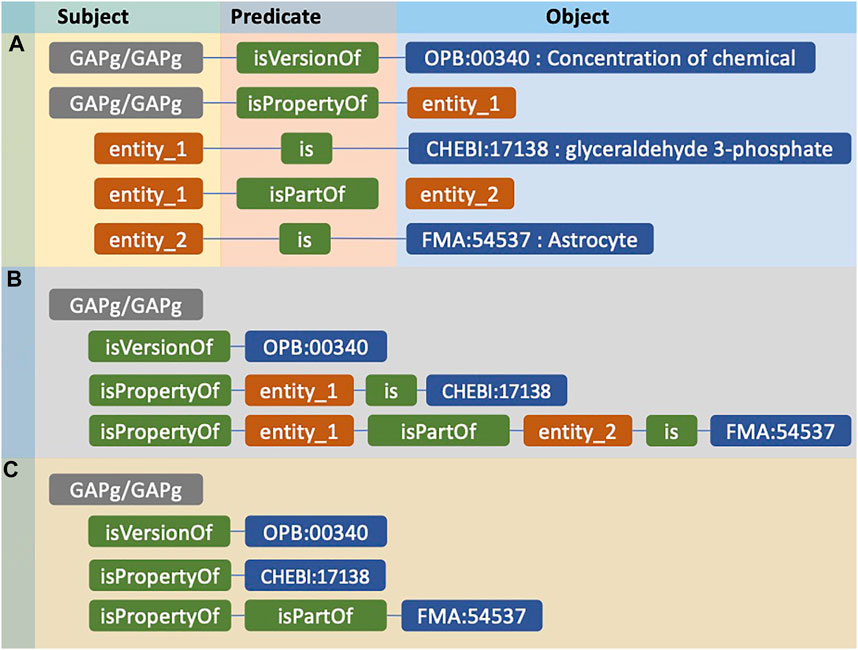
FIGURE 1. The example of an entity compositely annotated using RDF and its representation for further conversion to embedding. (A) The composite annotation of GAPg/GAPg entity by three ontology classes. (B) Paths consist of predicates connecting the entity to ontology classes. (C) The representation of the entity before converted to entity embedding.
Figure 2 illustrates the translation to the entity embedding process. Initially, CASBERT calculates the embedding of each path ept by combining its ontology class embedding ec and the average of predicate embeddings ep using Eq. 2; where ec and ep are calculated using Eq. (1). ec is the average of ontology class feature embeddings; for example, FMA:54537 has a preferred label feature of ‘Astrocyte’ and a synonym feature of ‘Astrocytus’. There are other features, such as parent labels and definitions, but using the selected two features only can give a higher performance (Munarko et al., 2022). For ep calculation, predicate terms in camelCase format are normalised to phrases in lowercase before converting to embeddings. For example, ‘isVersionOf’ and ‘isPartOf’ are changed to ‘is version of’ and ‘is part of’. Then, we limit the role of ep with wp between 0 and 1, which makes it lower than the role of the ontology class embedding. Finally, all path embeddings are averaged to get entity embedding ee as presented by Eq. (3).
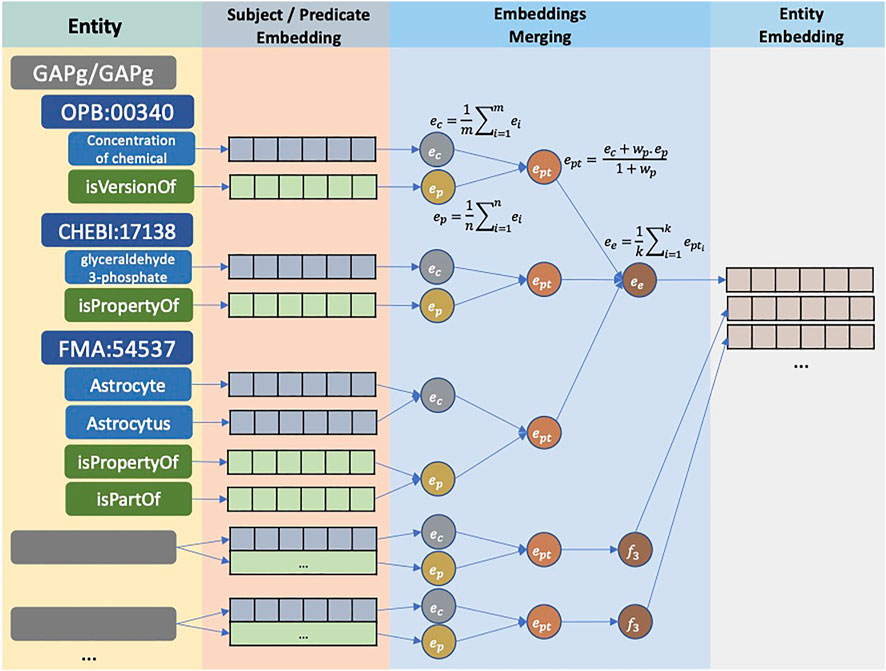
FIGURE 2. The conversion of entities to entity embeddings. For each entity, ontology classes and predicates are encoded into embeddings. Embeddings of ontology classes and predicates in one path are combined to form path embedding. Finally, all path embeddings are combined using the average function, creating an entity embedding.
2.2.2 Query embedding
Users create queries using keywords or natural language to search for entities. CASBERT represents these queries into query embeddings, so they are comparable to entity embeddings.
To explain the process of converting queries to query embeddings, we use ‘triose phosphate concentration in astrocytes’ as a running query example (see Figure 3). This query is intended to search for the GAPg/GAPg variable as in Table 1 where ‘triose phosphate’ is a synonym for ‘glyceraldehyde 3-phosphate’. A query can be assumed to be a composite annotation summary containing phrases about physiological and biochemical terms. CASBERT uses off-the-shelf natural language processing (NLP) method, SciSpacy (Neumann et al., 2019) with the ‘en_core_sci_scibert’ as Named Entity Recognition (NER) model, to identify these phrases; where for the query example, there are ‘concentration’, ‘triose phosphate’, and ‘astrocyte’. These phrases are converted to embeddings and combined by averaging (Eq. 4). We assume that these phrases correlate with ontology classes to some degree; therefore, the combined embedding eph is normalised by wph, which is the average of the maximum similarity of each phrase in p to ontology classes c. After converting into embeddings, the similarity between pi and cj follows Eq. 6.
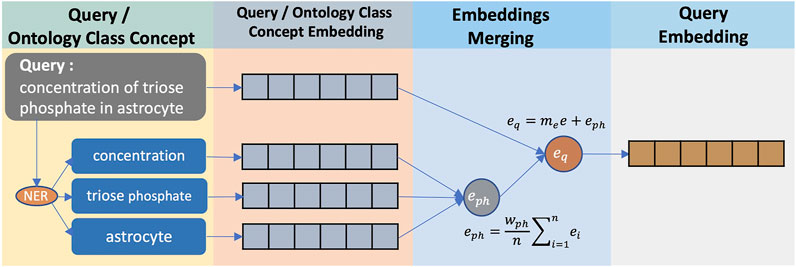
FIGURE 3. The conversion of a query to a query embedding. Phrases related to physiology and biochemical terms are identified using NER method, and then converted into embeddings using Sentence-BERT. These phrase embeddings are then averaged and combined with the entire query text embedding.
Furthermore, we take into account the relationship between phrases. This relationship is encoded explicitly or implicitly as conjunctions, prepositions, and the order of words. We capture this relationship by accounting for the overall query as an embedding e. The query embedding is then the addition of eph and e, where e is multiplied with the empirically decided multiplier me (see Eq. 5).
A few phrases may not have physiological or biochemical meaning and only complement other phrases. Therefore, their embeddings should be weighted lower and merged with the complemented phrase embedding. We use the wp value for experiment purposes, the same weight used in Eq. (2), to weight these phrase embeddings.
2.2.3 Entity retrieval
With the availability of the entity embedding list and query embedding, we can now calculate their similarities and present the relevant entities sorted from the most similar, as illustrated in Figure 4.
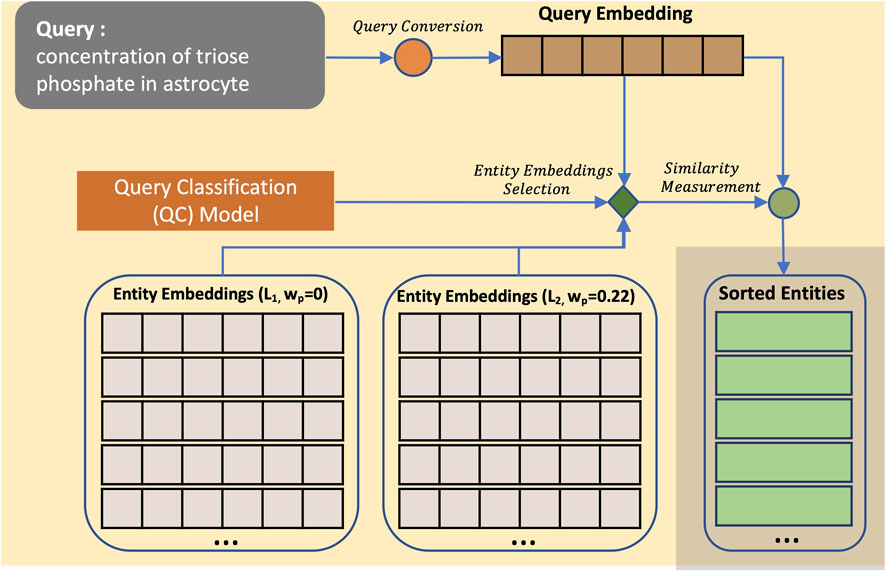
FIGURE 4. Entity search process using CASBERT. CASBERT provides entity embedding lists to choose from in the retrieval process according to the query type. Lists are distinguished by different wp values, for example, L1 with a value of 0 and L2 with a value of 0.22. At first, the query is converted to an embedding. Then, the embedding becomes the input of the Query Classifier (QC) model to select the correct entity embedding list. The entity results are then taken from the chosen entity embedding list and presented in a sorted order based on cosine similarity values.
2.2.3.1 Query - Entity Similarity
We implemented Cosine Similarity (CS) (Salton and McGill, 1983) to calculate the similarity value between a query embedding eq and an entity embedding ee. CS of two embeddings is the dot product of both embeddings divided by the multiplication of the magnitude of both embeddings (Eq. (6)). Thus, CS ignores the magnitude of each embedding, making it suitable for the high dimensionality nature of embedding. Additionally, ‘multi-qa-MiniLM-L6-cos-v1’ pre-trained sentence transformer model (Reimers and Gurevych, 2019) used to convert a sentence to an embedding in CASBERT is optimised with CS. This calculated value is later used to display the retrieval results from the highest to the lowest.
2.2.3.2 Query Classification
Considering that we can create multiple lists of entity embeddings with different wp (see Eq. (2)), we found that some queries can retrieve best when compared to a list with wp = 0, while others to a list with wp > 0. As an experiment, we created two lists, L1 with wp = 0 and L2 with wp = 0.22. Then we created the Query Classification (QC) model to classify queries to L1 or L2, where these classes are associated with the embedding list used for entity retrieval. The training data was extracted from partially combined query-entity sets in BM-CAQ. We calculated the value of mAP@10 (see Eq. (8)) of the selected query pairs to perform searches to L1 and L2. The highest value determines pair labelling to L1 or L2. The QC model was trained using Transformers (Wolf et al., 2020) and the ‘bert-base-uncased’ pre-trained model where the training data was initially augmented using nlpaug8 to increase its size and diversity. The training process in more detail is presented in Supplementary Figure S1.
3 Experiments and results
3.1 Experiment setup
We conducted experiments to measure CASBERT’s performance in searching for entities in the biosimulation models in the PMR and the BioModels database. Table 2 displays query-entity pair sets and retrieval methods used in this experiment. The data used is the BM-CAQ dataset, including noPredicate and withPredicate sets. Additionally, we combined the two sets into combine and used 60% of it for training and validation of the QC model and the remaining 40% for additional test data.
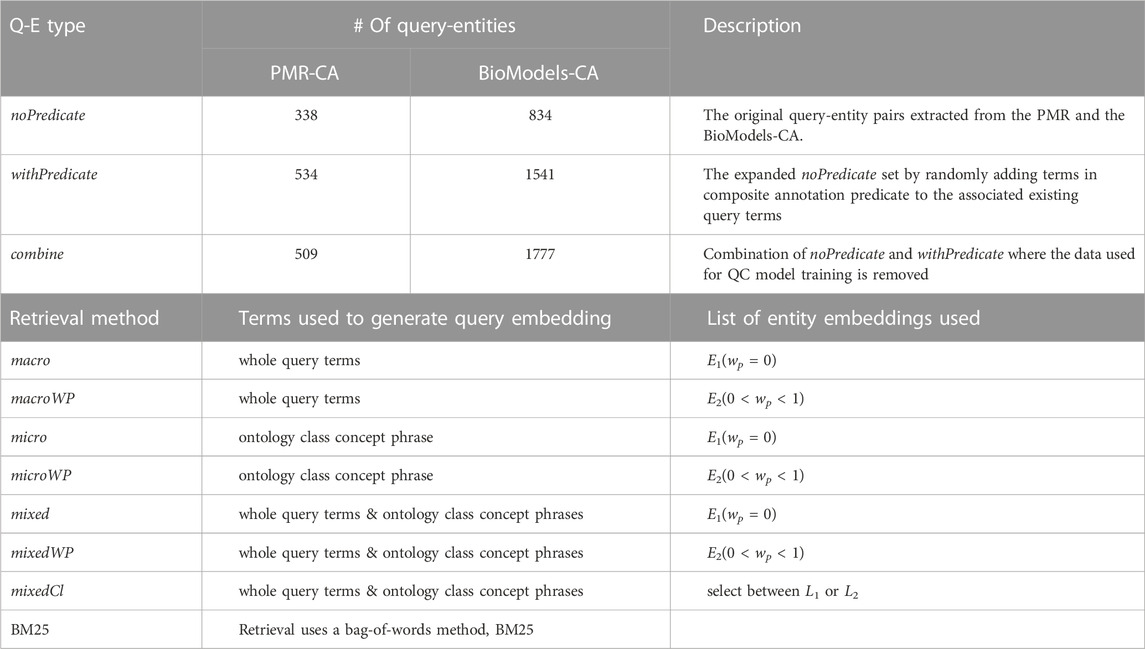
TABLE 2. The strategies to measure CASBERT performance. There are three query sets and eight retrieval methods including BM25 as the gold standard.
wp is a variable that defines the role of the predicate embedding, which is ideally lower than the role of the ontology class embedding. In this experiment, we want to demonstrate the difference in performance between retrieval methods using entity lists without predicates and entity lists with predicates. Therefore, we first created two entity embedding lists, L1 with wp = 0 and L2 with 0 < wp < 1. The wp value for L2 can be any arbitrary number as long as still in the correct range. Here, we choose 0.22 because it is small compared to the ontology class embedding weight, which is 1, and sufficient to represent the existence of predicates.
We tested three retrieval scenarios that yielded seven methods combined with entity embedding lists L1 and L2. We also measured the performance of BM25 (Robertson and Walker, 1994), a bag-of-words method, as the gold standard. The first scenario calculates the query embedding based on the query text only without identifying the phrases; when used to retrieve entities from L1 is named macro while from L2 is called macroWP. The following scenario uses phrases related to physiological and biochemical terms to generate query embeddings; when retrieving from L1, the method is called micro. The phrases are detected using the NER method, converted to embedding and combined using the averaging function. The additional use of non-physiological and biochemical phrases with this method, along with the retrieval from L2, is called microWP. Next, the third scenario combines the two initial scenarios using Eqss (4), (5), where the application for L1 and L2 are mixed and mixedWP consecutively. Here we set me = 1.9, which again is determined empirically by the logic that the query term as a whole is good enough to represent the query while the phrases within it can enhance the quality of the query representation as an embedding; therefore, me is more significant than wph. Finally, we apply L1 and L2 selection using the QC model with the third scenario as mixedCl.
3.2 Evaluation metric
We measured CASBERT performance for each set of query-entity pairs Q in the BM-CAQ dataset using Mean Average Precision for the top k results (mAP@k), Eq. (8). mAP@k is based on Average Precision at k (AP@k) as shown by Equation 7, where R is the number of relevant entities in the results, P@i is the proportion of relevant entities in the top i results, and r@i is a relevance function that returns 0 or 1 for the irrelevance or relevance of the entity at position i, respectively. Suppose there is a query-entity pair (q, es) in Q, where the number of es is at least one; then, with the query q, a retrieval method should be able to retrieve entities in es only. The number of search results that match this es is R. Furthermore, we set the value of k to 10 because search results are usually arranged in pages of 10 entities, and users are generally only interested in the first page.
Moreover, we also use Mean Reciprocal Rank (mRR) with Eq. (9) measuring the mean of the multiplicative inverse of the first entity in the retrieval results found to be relevant (ranksi). For example, given the query q, a retrieval method returns entities of k = 5 displayed in order of rank and relevance, 0 or 1, as {1: 0,2: 1,3: 0,4: 0,5: 1}. Then the Reciprocal Rank calculation (RR) only considers the ranking of the first relevant entity, {2: 1}, so the value of RR for q is 0.5. Then the value of mRR is calculated and averaged for all queries in Q.
3.3 Results
From Table 3, we can see that all of the methods used in CASBERT have higher mAP@10 and mRR than the gold standard BM25. The macro and macroWP perform reasonably well for all query-entity pair sets in the BM-CAQ. These methods are the most efficient because there is only one conversion to embedding for each query, so the retrieval process is faster. Meanwhile, the micro and microWP, which incorporate embeddings of phrases in the query, have the lowest measurement results among all the proposed methods. Using phrases alone overrides the relational information between phrases, resulting in lower performance. Strategies that combine embeddings of the whole query terms and phrases related to the concept of ontology classes (mixed, mixedWP, mixedCl) perform best (indicated by bold values in Table 3). These results show that the query text as a whole is sufficient to be converted into an embedding representing the query while embedding phrases helps increase the quality of query embedding. Moreover, in the mixedWP, using the QC model can slightly improve the retrieval quality and make it the best method. The QC model classifies queries for further retrieval from the appropriate entity embedding list, although the performance gains are modest.
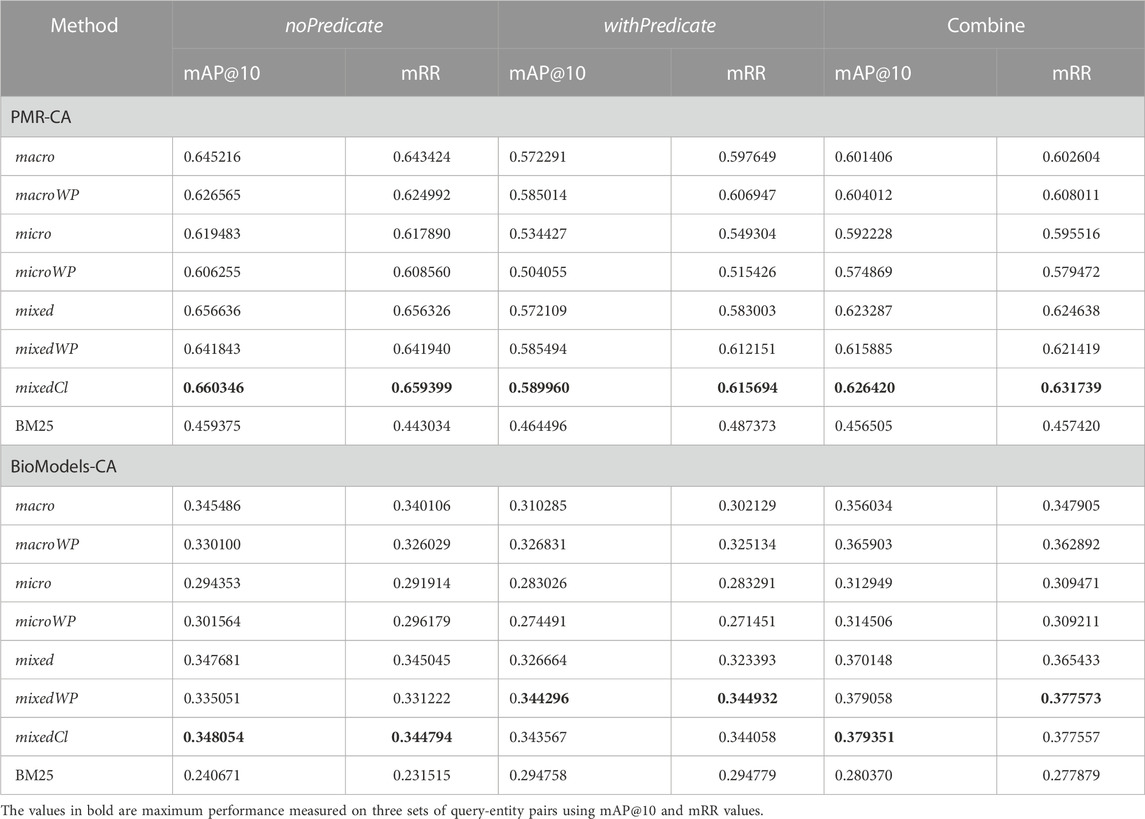
TABLE 3. CASBERT performance over three query-entity pair sets and seven searching methods compared to the bag-of-words method (BM25) measured using mAP@10 and mRR. The numbers of entities in the PMR and the BioModels are 4,652 and 54,456 respectively.
Based on the type of data for testing, the retrieval results from the PMR are better than those from the BioModels database. This difference is due to the more significant number of biosimulation models in the BioModels database, about twice the PMR, but their entities need to be annotated with more precision. By limiting the search to entities that are considered fully annotated, the performance is almost the same, as shown in the Supplementary Table S5.
Illustrating the effect of different mAP@10 and mRR values, Figure 5 shows the top 10 retrievals of entities for three query examples retrieved using mixedCl and BM25. Search results are organised in order from the left-hand side to the right-hand side based on the similarity values between queries and entity results, starting from the highest one. Three query-entity pairs are used in the noPredicate set. For the first and the third queries, mixedCl and BM25 retrieve the same number of relevant entities, indicated by blue boxes; however, the mixedCl presents the relevant entities earlier than BM25. Measured using AP@10 and RR, mixedCl raises higher values with a large margin. For the second example, mixedCl can retrieve more relevant entities and rank better. Overall, the mAP@10 and mRR of mixedCl is higher than BM25. A higher mAP@10 and mRR provide a better search experience with relevant entities served earlier or more.
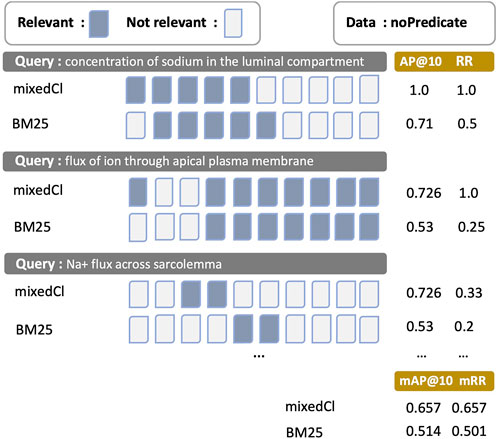
FIGURE 5. The presentation of search results differentiated by mAP@10 and mRR towards values. Blue boxes are relevant entities, while white boxes are irrelevant entities. mAP@10 and mRR are calculated from the results of the mixedCl and BM25 methods on the noPredicate query-entity pair set. Results are sorted in which entities with the higher similarity to the query are placed on the left-hand side. The results of the first and third queries are similar for both methods, but the use of mixedCl, with higher mAP@10 and mRR, can show relevant entities earlier than BM25.
4 Discussion
We have demonstrated that the adaptation of BERT-based embedding to encode entities’ composite annotations and queries in CASBERT can surpass the performance of the standard bag-of-words methods. This better performance is closely related to how BERT tokenises an input sentence and converts the token into embedding. BERT implements WordPiece tokeniser (Wu et al., 2016), a subword-based tokenisation algorithm. This algorithm can adequately accommodate wording variations, spelling errors, and missing white space issues. Therefore, unique words in specific domains, such as biology, can be segmented into appropriate tokens. These tokens are then converted into embeddings. For the token embedding to be unique to the position and sentence sequence, the representation of a token as an embedding is combined with the positional embedding and sentence sequence embedding. Hence, this combination can appropriately represent a sentence. Moreover, this way of embedding contributes to the generation of similar embeddings for sentences with synonymy meanings.
In the following subsections, we discuss CASBERT improvements, analysed based on different embedding generation methods. Then the discussion is followed by the possibility of implementing CASBERT in various domains and complementing SPARQL. Finally, we present our recommendations and future works.
4.1 Performance increase
As presented in Table 3, our proposed methods are quite effective in converting the entities’ composite annotations and queries to embeddings and retrieving relevant entities based on the provided query. The analysis of those methods and performance based on the similarity value between query and composite annotation is described below.
4.1.1 Entity’s composite annotation to embedding methods
We have experimented with creating entity embedding by considering predicates (0 < wp < 1) and not (wp = 0). Entity embeddings considering predicates are primarily suitable for queries containing the predicate terms or their synonyms; conversely, the ones without predicates usually are suitable for queries without predicate terms. This pattern is shown by the consecutive good measurement results of the mixedWP method on withPredicate set and the mixed method on noPredicate set. Intuitively, for high-performance retrieval, the entity embedding list selected should match the presence of predicate terms in the query. However, this approach will not outperform the mixedCl method since the average results of the stated evidence are lower than the average results of the mixedCl method on the same sets. This lower performance may be because the terms identified as predicates are unrelated to either the predicate or the ontology class. On the other hand, predicates that are not phrases, but are conjunctions and prepositions, cannot be detected, eliminating the possibility of selecting the proper entity embedding list. The mixedCl method uses the QC model to determine the query embedding list based on the overall query terms. The application of a BERT-based classifier for classification is proven to have better accuracy. Overall, mixedCl is best on nine measurements of mAP@10 and mRR and only slightly lower than the best of the other three (Table 3, bold values).
While only two wp values, 0 and 0.22, are used in this experiment, we predict that wp should be adaptive to the query, so in the future, we recommend specifying wp automatically. However, this adaptive wp approach will sacrifice the simplicity of the current entity’s composite annotation list because ontology class and predicate embeddings should be separately managed, and there should be a mechanism to create entity embedding with given wp value effectively.
4.1.2 Query to embedding methods
The empirical results show that the mixed scenario performs best, followed by macro and micro scenarios consecutively. The micro scenario is intended to detect phrases related to physiology and biochemical terms in a query and generate a query embedding by combining all phrase embeddings. However, the detection accuracy depends on the NER method’s performance in identifying the phrases and the query created by the user.
The macro scenario is better than the micro scenario. This higher performance could be related to encoding whole query terms containing all phrases related to physiology and biochemical terms, including their relationship in a single embedding unit. However, individual phrases are not considered, allowing slight entity detection inaccuracies. Overall, this scenario is the most efficient because it only performs a one-step conversion from query to embedding, in contrast with the other scenarios that identify multiple phrases and convert to embeddings and then combine them.
The mixed scenario can slightly increase mAP@10 and mRR. As expected, this merge takes good account of the macro scenarios’s advantages and emphasises the critical phrases provided in the query. To avoid the decisive role of the phrases related to physiology and biochemical terms, delimiting with wph (Eq. 4) can give adequate proportion. Although this scenario is not the most efficient, its computational cost is linearly increased depending on the identified phrases. Due to its highest effectiveness, we recommend the mixed scenario to be implemented for composite annotation search.
4.1.3 Performance analysis based on the similarity of query and Entity’s composite annotation
Figure 6 shows CASBERT’s ability in retrieving entities for various queries differentiated by their similarity to relevant entities for PMR-CA. We calculated the similarity directly using the query embedding generated with the macro method against the entity embedding. CASBERT performance is higher than BM25 when the similarity value is more than 0.3 and achieves the highest margin for similarity from 0.5 to 0.9, covering about 96% of the total test data. This pattern indicates CASBERT benefits because most user queries fall within this range. For very low query-entity similarity, 0.1 to 0.2, BM25 is better because a limited number of the same terms, one or two, can direct the query to relevant entities. In contrast, embedding in CASBERT may lead the query to entities with different terms but having the same context. Unfortunately, the combination of a low similarity value and the absence of a common term results in lower performance. Furthermore, we found a similar pattern for BioModels-CA, although we do not measure performance for low query-entity similarity values (see Supplementary Figure S2 and Supplementary Table S5).
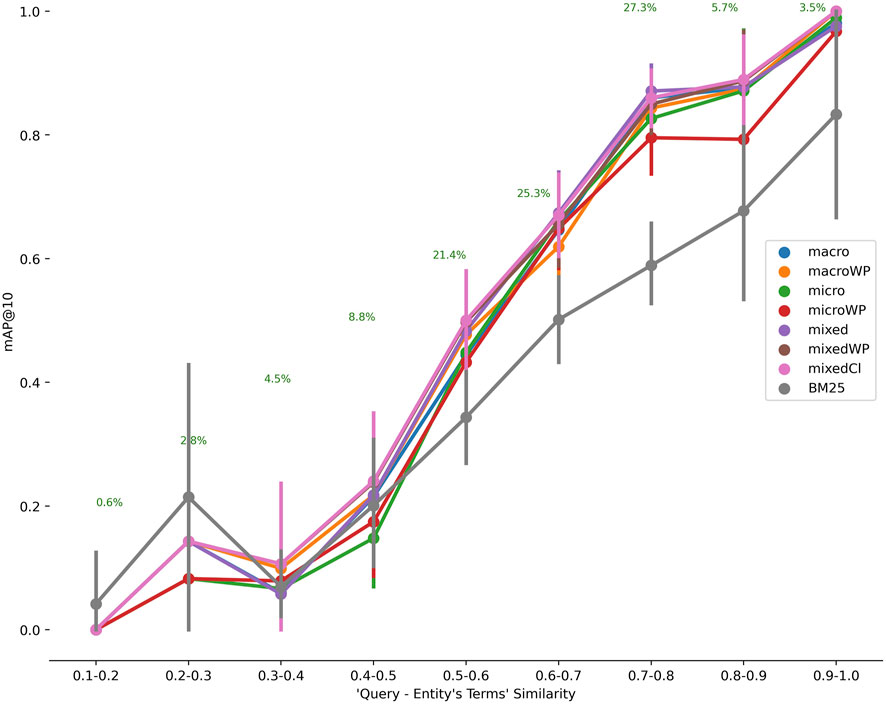
FIGURE 6. The relationship between the similarity of terms in the query with those in the entity to mAP@10 for PMR-CA. The number of entities is 4,652 and the number of test data is 509. Generally CASBERT is better than BM25 when the similarity value is 0.3 and above.
4.2 Recommendations and future works
4.2.1 Other domain implementation
We have shown CASBERT can well represent compositely annotated entities as embeddings. Although the data we use come from a repository of biosimulation models, implementation in other domains such as chemistry, pharmacy or medicine is possible as long as they are annotated using RDF and have ontology dictionaries. The entity retrieval process is started by modifying the input query to embedding using the mixed method or macro method for more straightforward implementation and then measuring query-entity similarity using cosine similarity. Moreover, most of the BERT models we used are pre-trained models without further fine tuning, except query classification modes; therefore, the implementation in other domains with no training data is still accessible.
4.2.2 Search engine implementation
The embeddings representing entities now can be managed in a list of embeddings. The list is more straightforward than the standard indexing technique in search retrieval systems such as the inverted index. New embeddings can be easily attached to the list; even deletion, insertion, and replacement require only a minimum effort; therefore, overall maintenance will be cheaper. More importantly, we can avoid traditional search engine complexities, including preprocessing (stemming, case folding, stop word removal, spelling corrections, and lemmatisation), synonyms and abbreviations handlings.
4.2.3 Cross repositories search
We estimate that it is possible to find similar information from different repositories with the same domain. Table 4 shows the example of two queries with their results from the PMR and the BioModels database. The query ‘concentration of triose phosphate in astrocyte’, ‘triose phosphate’ is correctly mapped to CHEBI:17138 in entities from both repositories, whereas ‘concentration’ and ‘astrocyte’ are mapped to different entities but with interrelated properties. Furthermore, the query ‘ammonium in cytoplasm’ also gives similar results with the mapping of ‘ammonium’ in entities from both queries was CHEBI:28938, while ‘cytoplasm’ as FMA:66836 (Portion of cytosol) in the PMR and GO:0005737 (cytoplasm) at the BioModels database. These results suggest that multiple repositories can be combined in a single search system to complement each other and be used for possible confirmation and reuse of models across repositories.
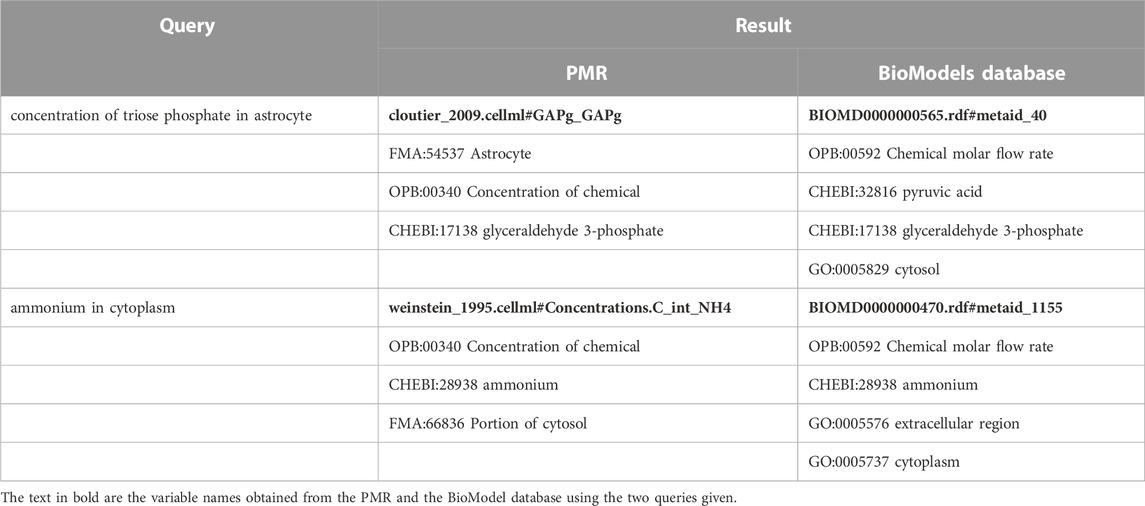
TABLE 4. The example of entities retrieved from different repositories, the PMR and the BioModels database. Those entities have similarities in the ontology classes related to the queries.
4.2.4 CASBERT for SPARQL
SPARQL and CASBERT have a similar intent to get information from RDF documents. SPARQL is rigid and can extract precise details as long as the information about the ontology and structure of the RDF document is known. In comparison, CASBERT is relaxed in exploring information freely where ontology knowledge is not mandatory. Therefore, both methods are not interchangeable, but CASBERT can supplement SPARQL to understand the structure of the RDF document and the ontology classes involved.
4.2.5 Future works
We account for composite annotation structure and combine ontology class and predicate embeddings to calculate entity embedding. This combination involves two variables, me and wp, whose values adjust the search object and possibly the query type for maximum performance. We have currently prototyped a search engine9 that, once deployed, can collect query logs containing user activities in searching. Using these logs, we can analyse user behaviour and the relationship between the query and the relevant entity. We thought that by leveraging this relation and applying a grid search, CASBERT could automatically determine the value combinations of me and wp.
We are leveraging a Transformers-based method, Sentence-BERT, to convert text into embeddings. As an alternative, there is InferSent (Conneau et al., 2017), based on Bi-LSTM, and universal Sentence Encoder (USE) (Cer et al., 2018), based on Deep Averaging Network (DAN) and Transformers. Sentence-BERT is superior for sentiment analysis tasks but inferior to USE for TREC data for query classification tasks (Reimers and Gurevych, 2019). For our purposes, we believe Sentence-BERT is better than other methods because of its better understanding of context. The tokens used are WordPieces (Schuster and Nakajima, 2012) rather than words, so they can more precisely represent unique words in the biosimulation modelling domain and are more resistant to typos. In comparison, the method using Bi-LSTM combines the two-way conversion results, from left to right and vice versa, which are calculated separately. However, we will implement some text-to-embedding conversion methods as an option, as LSTM-based methods may be better for performance in other small data and systems with CPU only. Moreover, we will compare their performance for various purposes using CASBERT.
Further study in cross-repositories retrieval also needs to be considered; hence, it can promote reusability between repositories.
5 Conclusion
The increasing availability of composite annotation to describe entities in biosimulation models requires a simple tool to access information inside by ordinary users. We propose CASBERT, a BERT based method providing keyword-based searching that effectively manages composite annotations and retrieves entities using a text query. This effectiveness is achieved by converting the entities’ composite annotations to embeddings and organising them in a list; therefore, adding, deleting, inserting, and modifying embedding is cheaper. Getting relevant entities using a previously converted query to an embedding is straightforward with this structure. Using query-entities pairs test data extracted from the PMR and the BioModels database, empirically, CASBERT can retrieve better than bag-of-words methods such as BM25. It can potentially give a better user experience than the traditional approach. In the future, we are interested in developing a cross-repositories search engine to encourage biosimulation model reuse between different repositories.
Data availability statement
Publicly available datasets were analyzed in this study. This data can be found here: https://github.com/napakalas/casbert.
Author contributions
YM, AR, and DN contributed to the conception and design of the study. YM implemented CASBERT, performed the analysis and wrote the first draft of the manuscript. All authors contributed to the testing and evaluation of CASBERT and wrote sections of the manuscript. All authors contributed to the manuscript revision, read and approved the submitted version.
Funding
The authors acknowledge financial support by the Aotearoa Foundation, Auckland Bioengineering Institute, and the National Institutes of Health (grant P41 GM109824).
Conflict of interest
Author AR is employed by The New Zealand Institute for Plant & Food Research Ltd.
The remaining authors declare that the research was conducted in the absence of any commercial or financial relationships that could be construed as a potential conflict of interest.
Publisher’s note
All claims expressed in this article are solely those of the authors and do not necessarily represent those of their affiliated organizations, or those of the publisher, the editors and the reviewers. Any product that may be evaluated in this article, or claim that may be made by its manufacturer, is not guaranteed or endorsed by the publisher.
Supplementary material
The Supplementary Material for this article can be found online at: https://www.frontiersin.org/articles/10.3389/fbinf.2023.1107467/full#supplementary-material
Footnotes
4https://github.com/napakalas/casbert/.
5https://models.physiomeproject.org/workspace/5af/.
6as of July 2020.
7https://github.com/napakalas/casbert-experiment/.
8https://github.com/makcedward/nlpaug.
9https://github.com/napakalas/bmse/.
References
Arora, S., May, A., Zhang, J., and Ré, C. (2020). Contextual embeddings: When are they worth it? arXiv:2005.09117 [cs]. ArXiv:2005.09117 [cs]. doi:10.48550/arXiv.2005.09117
Bassingthwaighte, J. B. (2000). Strategies for the physiome project. Ann. Biomed. Eng. 28, 1043–1058. doi:10.1114/1.1313771
Bromley, J., Guyon, I., LeCun, Y., Säckinger, E., and Shah, R. (1993). “Signature verification using a ”Siamese” time delay neural network,” in NIPS’93: Proceedings of the 6th International Conference on Neural Information Processing Systems (San Francisco, CA, USA: Morgan Kaufmann Publishers Inc.), 737–744.
Cer, D., Yang, Y., Kong, S. Y., Hua, N., Limtiaco, N., John, R. S., et al. (2018). Universal sentence encoder. ArXiv:1803.11175 [cs]. doi:10.48550/arXiv.1803.11175
Chelliah, V., Juty, N., Ajmera, I., Ali, R., Dumousseau, M., Glont, M., et al. (2015). BioModels: Ten-year anniversary. Nucleic Acids Res. 43, D542–D548. doi:10.1093/nar/gku1181
Cloutier, M., Bolger, F. B., Lowry, J. P., and Wellstead, P. (2009). An integrative dynamic model of brain energy metabolism using in vivo neurochemical measurements. J. Comput. Neurosci. 27, 391–414. doi:10.1007/s10827-009-0152-8
Conneau, A., Kiela, D., Schwenk, H., Barrault, L., and Bordes, A. (2017). Supervised learning of universal sentence representations from natural language inference data. arXiv preprint arXiv:1705.02364.
Cook, D. L., Mejino, J. L. V., Neal, M. L., and Gennari, J. H. (2008). Bridging biological ontologies and biosimulation: The ontology of physics for biology. AMIA Annu. Symp. Proc. 2008, 136–140.
Cuellar, A. A., Lloyd, C. M., Nielsen, P. F., Bullivant, D. P., Nickerson, D. P., and Hunter, P. J. (2003). An overview of CellML 1.1, a biological model description language. Simulation 79, 740–747. doi:10.1177/0037549703040939
Degtyarenko, K., de Matos, P., Ennis, M., Hastings, J., Zbinden, M., McNaught, A., et al. (2008). ChEBI: A database and ontology for chemical entities of biological interest. Nucleic Acids Res. 36, D344–D350. doi:10.1093/nar/gkm791
Devlin, J., Chang, M. W., Lee, K., and Toutanova, K. (2018). Bert: Pre-training of deep bidirectional transformers for language understanding. arXiv preprint arXiv:1810.04805 Tex.ids= devlin_bert_2019 arXiv: 1810.04805
Garny, A., and Hunter, P. J. (2015). OpenCOR: A modular and interoperable approach to computational biology. Front. Physiology 6, 26. doi:10.3389/fphys.2015.00026
Gehring, J., Auli, M., Grangier, D., Yarats, D., and Dauphin, Y. N. (2017). “Convolutional sequence to sequence learning,” in Proceedings of the 34th International Conference on Machine Learning (PMLR), Sydney, Australia, 1243–1252. ISSN: 2640-3498.
Gennari, J. H., König, M., Misirli, G., Neal, M. L., Nickerson, D. P., and Waltemath, D. (2021). OMEX metadata specification (version 1.2). J. Integr. Bioinforma. 18, 20210020. doi:10.1515/jib-2021-0020
Gennari, J. H., Neal, M. L., Galdzicki, M., and Cook, D. L. (2011). Multiple ontologies in action: Composite annotations for biosimulation models. J. Biomed. Inf. 44, 146–154. doi:10.1016/j.jbi.2010.06.007
Hucka, M., Finney, A., Sauro, H. M., Bolouri, H., Doyle, J. C., Kitano, H., et al. (2003). The systems biology markup language (SBML): A medium for representation and exchange of biochemical network models. Bioinformatics 19, 524–531. doi:10.1093/bioinformatics/btg015
Hunter, P., Robbins, P., and Noble, D. (2002). The IUPS human physiome project. Pflügers Arch. 445, 1–9. doi:10.1007/s00424-002-0890-1
Munarko, Y., Sarwar, D. M., Rampadarath, A., Atalag, K., Gennari, J. H., Neal, M. L., et al. (2022). NLIMED: Natural Language Interface for model entity discovery in biosimulation model repositories. Front. Physiology 13, 820683. doi:10.3389/fphys.2022.820683
Neal, M. L., König, M., Nickerson, D., Mısırlı, G., Kalbasi, R., Dräger, A., et al. (2019). Harmonizing semantic annotations for computational models in biology. Briefings Bioinforma. 20, 540–550. doi:10.1093/bib/bby087
Neumann, M., King, D., Beltagy, I., and Ammar, W. (2019). “ScispaCy: Fast and robust models for biomedical Natural Language processing,” in Proceedings of the 18th BioNLP Workshop and Shared Task (Florence, Italy: Association for Computational Linguistics), 319–327. ArXiv: 1902.07669. doi:10.18653/v1/W19-5034
Pérez, J., Arenas, M., and Gutierrez, C. (2009). Semantics and complexity of SPARQL. ACM Trans. Database Syst. 34, 1:1–16:45. doi:10.1145/1567274.1567278
Reimers, N., and Gurevych, I. (2019). “Sentence-BERT: Sentence embeddings using siamese BERT-networks,” in Proceedings of the 2019 Conference on Empirical Methods in Natural Language Processing (Florence, Italy: Association for Computational Linguistics).
Robertson, S. E., and Walker, S. (1994). “Some simple effective approximations to the 2-Poisson model for probabilistic weighted retrieval,” in SIGIR ’94. Editors B. W. Croft,, and C. J. van Rijsbergen (London: Springer), 232–241.
Rosse, C., and Mejino, J. L. V. (2008). “The foundational model of anatomy ontology,” in Anatomy ontologies for Bioinformatics: Principles and practice. Computational biology. Editors A. Burger, D. Davidson, and R. Baldock (London: Springer), 59–117. doi:10.1007/978-1-84628-885-2_4
Salton, G., and McGill, M. J. (1983). Introduction to modern information retrieval. New York, NY, USA: McGraw-Hill.
Sarwar, D. M., Kalbasi, R., Gennari, J. H., Carlson, B. E., Neal, M. L., Bono, B. d., et al. (2019). Model annotation and discovery with the physiome model repository. BMC Bioinforma. 20, 457. doi:10.1186/s12859-019-2987-y
Schuster, M., and Nakajima, K. (2012). “Japanese and Korean voice search,” in 2012 IEEE International Conference on Acoustics, Speech and Signal Processing (ICASSP) (Kyoto, Japan: IEEE), 5149–5152. ISSN: 2379-190X. doi:10.1109/ICASSP.2012.6289079
Soru, T., Marx, E., Moussallem, D., Publio, G., Valdestilhas, A., Esteves, D., et al. (2020). SPARQL as a foreign language. arXiv:1708.07624 [cs] ArXiv: 1708.07624.
Taillé, B., Guigue, V., and Gallinari, P. (2020). “Contextualized embeddings in named-entity recognition: An empirical study on generalization,” in Advances in information retrieval (Cham: Springer), 383–391. doi:10.1007/978-3-030-45442-5_48
Tran, H., Phan, L., Anibal, J., Nguyen, B. T., and Nguyen, T.-S. (2021). “SPBERT: An efficient pre-training BERT on SPARQL queries for question answering over knowledge graphs,” in Neural information processing. Lecture notes in computer science. Editors T. Mantoro, M. Lee, M. A. Ayu, K. W. Wong, and A. N. Hidayanto (Cham: Springer International Publishing), 512–523. doi:10.1007/978-3-030-92185-9_42
Vaswani, A., Shazeer, N., Parmar, N., Uszkoreit, J., Jones, L., Gomez, A. N., et al. (2017). “Attention is all you need,” in Advances in neural information processing systems (Red Hook, NY, USA: Curran Associates, Inc.), Vol. 30.
Weinberger, K. Q., and Saul, L. K. (2009). Distance metric learning for large margin nearest neighbor classification. J. Mach. Learn. Res. 10, 207–244.
Welsh, C., Nickerson, D. P., Rampadarath, A., Neal, M. L., Sauro, H. M., and Gennari, J. H. (2021). libOmexMeta: enabling semantic annotation of models to support FAIR principles. Bioinformatics 37, 4898–4900. doi:10.1093/bioinformatics/btab445
Wolf, T., Debut, L., Sanh, V., Chaumond, J., Delangue, C., Moi, A., et al. (2020). HuggingFace’s transformers: State-of-the-art Natural Language processing. arXiv:1910.03771 [cs] ArXiv: 1910.03771.
Wu, Y., Schuster, M., Chen, Z., Le, Q. V., Norouzi, M., Macherey, W., et al. (2016). Google’s neural machine translation system: Bridging the gap between human and machine translation. arXiv:1609.08144 [cs] ArXiv: 1609.08144.
Yin, X., Gromann, D., and Rudolph, S. (2021). Neural machine translating from natural language to SPARQL. Future Gener. Comput. Syst. 117, 510–519. doi:10.1016/j.future.2020.12.013
Keywords: BERT, sentence-BERT, information retrieval, composite annotation embedding, RDF, ontology, biomodels, physiome model repository (PMR)
Citation: Munarko Y, Rampadarath A and Nickerson DP (2023) CASBERT: BERT-based retrieval for compositely annotated biosimulation model entities. Front. Bioinform. 3:1107467. doi: 10.3389/fbinf.2023.1107467
Received: 24 November 2022; Accepted: 31 January 2023;
Published: 14 February 2023.
Edited by:
Livia Perfetto, Sapienza University of Rome, ItalyReviewed by:
Anna Bernasconi, Politecnico di Milano, ItalyIvo Siekmann, Liverpool John Moores University, United Kingdom
Copyright © 2023 Munarko, Rampadarath and Nickerson. This is an open-access article distributed under the terms of the Creative Commons Attribution License (CC BY). The use, distribution or reproduction in other forums is permitted, provided the original author(s) and the copyright owner(s) are credited and that the original publication in this journal is cited, in accordance with accepted academic practice. No use, distribution or reproduction is permitted which does not comply with these terms.
*Correspondence: Yuda Munarko, eW11bjc5NEBhdWNrbGFuZHVuaS5hYy5ueg==
 Yuda Munarko
Yuda Munarko Anand Rampadarath
Anand Rampadarath David P. Nickerson
David P. Nickerson